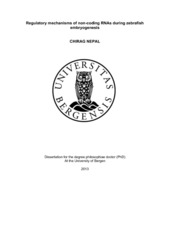| dc.contributor.author | Nepal, Chirag | eng |
| dc.date.accessioned | 2013-09-17T07:49:02Z | |
| dc.date.available | 2013-09-17T07:49:02Z | |
| dc.date.issued | 2013-05-03 | eng |
| dc.identifier.isbn | 978-82-308-2283-8 | en_US |
| dc.identifier.uri | https://hdl.handle.net/1956/7202 | |
| dc.description.abstract | For many years, RNAs were thought to be intermediate products between DNA and protein. The discovery of RNA interference (RNAi), a regulatory process that uses small non-coding RNAs to regulate gene expression at the post-transcriptional level, changed our view about RNAs. However, the discovery of microRNAs was the realization of RNAs as the regulatory elements. In recent years, many highthroughput sequencing studies have identified hundreds to thousands of various kinds of non-coding RNAs. The existence and biological relevance of these noncoding RNAs detected in large-scale analysis of human tissues have not yet been characterized in a vertebrate animal in vivo. To gain insight into the existence and biological relevance of these non-coding RNAs in vertebrate animal in vivo, we have set out to generate the first global description of TSS usage during key stages of vertebrate embryonic development at single nucleotide resolution. We have coupled CAGE maps to protein-coding and non-coding transcripts by RNA sequencing (providing a quantitative description of TSS usage on a genome scale) and anchored to posttranslational histone modifications (H3K4me3) by ChIP sequencing. We reveal an extraordinary dynamics of promoter usage that takes place during development of the vertebrate embryo. We showed that the onset of transcription and subsequent differentiation of the embryo is characterized by the developmentally regulated appearance of 5’-ends of intragenic RNAs on many genes, and of an entire hitherto unknown layer of RNA species overlapping known genes and having specific signatures occurring in exons, introns and 3’-UTRs of developmentally active genes. We characterize the pervasive production of intragenic processed RNAs including exonic and intron-5’ end specific RNAs and provide the first indication for the biological processes in which they may function. Notably, intron 5’ end associated non-coding RNAs are active zygotically and restricted to genes that encode RNA processing and the splicing proteins in both fish and human. We demonstrated evidence that exonic RNAs are produced by a non-canonical posttranscriptional mechanism independent of the gene 5’ end. We show the initiation landscape and developmental dynamics of lincRNAs; we show the evolutionary conserved process of developmentally regulated posttranscriptional processing of lincRNAs into intragenic RNAs, which demonstrate the utility of zebrafish in studying mammalian lincRNA processing. The main aim of this work was to provide a (currently non-existent) annotation of miRNA promoters and characterize their common characteristics features at transcription, post transcription and chromatin level. We describe the first genomewide identification of miRNA promoters in zebrafish active during the early embryonic developmental stages. We identified a small number of maternally transcribed miRNAs, one MBT specific miRNA and the majority that are zygotically transcribed. We report the first evidence of moRNAs in zebrafish and pufferfish that were previously reported in human and Ciona intestinalis. We show evidence for unexpected enrichment of pre-miRNA sites with promoter-associated histone modification marks (H3K4me3 and H2A.Z) suggesting chromatin regulation and potential involvement of transcription machinery in pre-miRNA processing, suggesting co-transcriptional splicing of pre-miRNAs and pri-miRNA. We have provided a catalogue of intermediate-sized non-coding RNAs in zebrafish, by making RNA library enriched for intermediate-sized (50-500 nt) non-coding RNAs, collected from zebrafish larvae (5-7 days post fertilization). In particular, we validated most annotated snoRNAs and identified few hundreds of novel snoRNAs making the most comprehensive annotations of zebrafish snoRNAs. Host genes for most snoRNAs showed no evidence for independent transcription of snoRNAs, suggesting they are co-transcribed by host genes. Interestingly, host (coding and non-coding) genes require non-canonical transcription initiation machinery, as indicated by TCT initiation signals, that is associated with translation machinery. 5’-end of many snoRNAs overlaps with CAGE 5’-ends, suggesting either they are capped or undergo post-transcriptional modification, which is also evolutionary conserved in human snoRNAs. Small RNAs derived from snoRNAs are generated from most snoRNAs and provide first evidence of sd-snoRNAs produced in oocytes, suggesting their potential importance during early embryogenesis. | en_US |
| dc.language.iso | eng | eng |
| dc.publisher | The University of Bergen | en_US |
| dc.relation.haspart | Paper I: Chirag Nepal, Yavor Hadzhiev, Christopher Previti, Vanja Haberle, Nan Li, Hazuki Takahashi, Ana Maria S. Suzuki, Ying Sheng, Rehab F. Abdelhamid, Santosh Anand, Jochen Gehrig, Altuna Akalin, Christel E.M. Kockx, Antoine A.J. van der Sloot, Wilfred F.J. van IJcken, Olivier Armant, Sepand Rastegar, Uwe Strähle, Elia Stupka, Piero Carninci, Boris Lenhard, Ferenc Müller, Dynamic regulation of coding and non-coding transcription initiation landscape at single nucleotide resolution during vertebrate embryogenesis. Manuscript submitted. Full-text not available in BORA. | en_US |
| dc.relation.haspart | Paper II: Chirag Nepal, Yavor Hadzhiev, Vidar M Steen, Piero Carninci, Ferenc Müller, Boris Lenhard, Transcriptional, post-transcriptional and chromatin associated regulation of primiRNAs, pre-miRNAs and moRNAs in zebrafish development. Manuscript. Full-text not available in BORA. | en_US |
| dc.relation.haspart | Paper III: Chirag Nepal, Estefanía Tarifeño-Saldivia, Wei Deng, Pål Sætrom, Christopher Previti, Bernard Peers, Ferenc Müller, Boris Lenhard, Genome wide characterization of snoRNAs in zebrafish reveals their co-transcription with coding and long non-coding host genes by non-canonical transcription initiation. Manuscript. Full-text not available in BORA. | en_US |
| dc.title | Regulatory mechanisms of non-coding RNAs during zebrafish embryogenesis | en_US |
| dc.type | Doctoral thesis | |
| dc.rights.holder | Copyright the author. All rights reserved | en_US |
